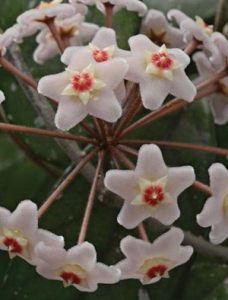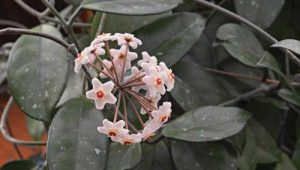Sally Benson — June 3, 2015
My grandmother was an early adopter, of sorts. She kept all manner of house plants, especially in the parlor, but toted them out to the front porch in summer to dazzle the neighbors with their color and her horticultural skills. Using tropicals out of zone? Grandma Lill did it long ago.
Most of these plants were acquired through, shall we say, unusual means. In the 1930s, she and my grandfather  drove Way Out West, as she used to put it, and brought back cacti and succulents the likes of which suburban Chicagoans had never seen. Now used quite commonly, plants like the colorful Kalanchoe were her pride and joy.
drove Way Out West, as she used to put it, and brought back cacti and succulents the likes of which suburban Chicagoans had never seen. Now used quite commonly, plants like the colorful Kalanchoe were her pride and joy.
One treasure that she shared with the family, however, was her special hoya plant (Hoya carnosa; wax plant). My mother, my sisters and I each were given a cutting and were told to pot it up and “let it be.” This mysterious vine, we were told, was smuggled into the U.S. under the woolen coat of a friend who emigrated from Sweden, and if these young cuttings were kept in the family, they’d live forever. It’s likely she ran across it in someone’s hothouse, but that was Lill: the more fanciful the story, the more valuable the gift.
But she was right about one thing: Hoya is known for its longevity. If memory serves, I received my cutting in 1972. And from what I understand, it’s still thriving. The plant moved with me from dorm rooms to apartments to houses and finally to Colorado, where a friend graciously agreed to “watch” it for me until I returned. That was two decades ago, and she says it’s still blooming regularly.
Name: Hoya carnosa
Common Name: Hoya; wax plant
Hardiness: Zones 10 to 12
Mature height: 2 to 4 feet
Mature spread: Up to 20 feet
Classification: Perennial vine
Landscape use: Houseplant in colder climates; may be used on the patio as a tropical accent
Ornamental characteristics: Glossy, pointed leaves cling to slender vines; small clusters of velvety, star-shaped flowers emerge from tight, waxy buds. Each small flower supports a distinctive, star-shaped corona with a red center. Richly fragrant.
Hoya carnosa is native to India, China and Australia (Sweden? Doubtful.), and has been used in the U.S. as a houseplant in colder climates; as a vigorous climber in more tropical zones. Very glossy and fleshy, pointed leaves grow up to 4 inches long; some varieties are variegated with white spots or margins. It’s been my experience that the vines can grow to 20 feet or so. My mother kept hers in her small greenhouse, where it reached the ceiling and wandered all the way around the structure, weaving itself through and among other plants. I kept mine in check by winding tendrils back among other foliage, and a very dense, bushy plant was the result.
The most thrilling feature of hoya, though, is its distinctive clusters of starshaped flowers, which begin as tight, waxy little pods. I was surprised by these in the eighth or ninth year of my ownership. The vine had grown beautifully in reduced light, but once I gave it bright, indirect light the clusters began to emerge. When the pods opened early one morning, the rich fragrance was enough to rouse me from a sound sleep.

Hoya is not fussy; given filtered sun indoors or out, with a good half day of direct sun, flowers should appear soon after acquisition. Standard potting soil is sufficient, and allow it to become nearly dry between waterings. The Bensons all moved their hoyas easily from living room to deck or patio and back without harm; that is, as long as night temps were mild. Below 45 or 50°, and it’s time to bring them in for the season. Pests? Nothing serious.